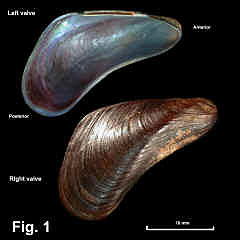|
|
MYTILIDA |
|
|
|
Xenostrobus securis (Lamarck, 1819) Description: Shape equivalve, elongate, with umbo at anterior end; variable in shape between specimens. Strong keel from umbo towards posterior. Dorsal margin straight; postero-dorsal end extended, broadly rounded; ventral margin concave. Hinge without teeth. Ligament long. Interior scars of posterior pedal retractor muscle and adductor muscle combined to give a single elongate scar posteriorly. Exterior with irregular concentric growth ridges. Colour of exterior dark brown to black; interior mainly purple. Periostracum smooth, dark brown to black. Size: Up to 38 mm in length. Distribution: Townsville, Qld, southwards and around southern Australia, to Moore River, north of Perth, including Tasmania. Also New Zealand, and introduced accidentally into Japan. Habitat: “In masses on timber, stones or dead shells in upper reaches of estuaries where the water may be almost fresh for a considerable part of the year” (Wilson, 1967). Comparison: Xenostrobus securis and X. pulex are very similar small dark mussels and virtually impossible to separate on shell characters. But X. securis grows to 38 mm in length, while X. pulex rarely exceeds 25 mm. But they are easily separated by habitat: X. pulex lives on the open coast while X. securis lives in the upper reaches of estuaries, up to the limit of tidal influence. They are genetically separable. Synonymy: The name Perna confusa Angas, 1871 was used in some Australian literature before the taxonomy was clarified by Wilson (1967). Remarks: The species Xenostrobus pulex (Lamarck, 1811) is very similar to X. securis and virtually impossible to separate on shell characters. Although some old literature reported it from Sydney, it seems unlikely that it occurs in central NSW, given the understanding of the species and its distribution established by Wilson (1967). However, in that paper Wilson did say that it occurred as far north as Jervis Bay, but gave no details of specimens examined. The Australian Museum collection holds no specimens from NSW but Dr Don Colgan reported that X. pulex occurs at Cape Conran, about 100 km south of the Vic-NSW border (Colgan, in litt., 2022). The limit of distribution is apparently around the Vic-NSW border, so it may well be recorded in southern NSW from time to time. Fig. 1: Lane Cove River, Sydney (C.119002)
|
|
